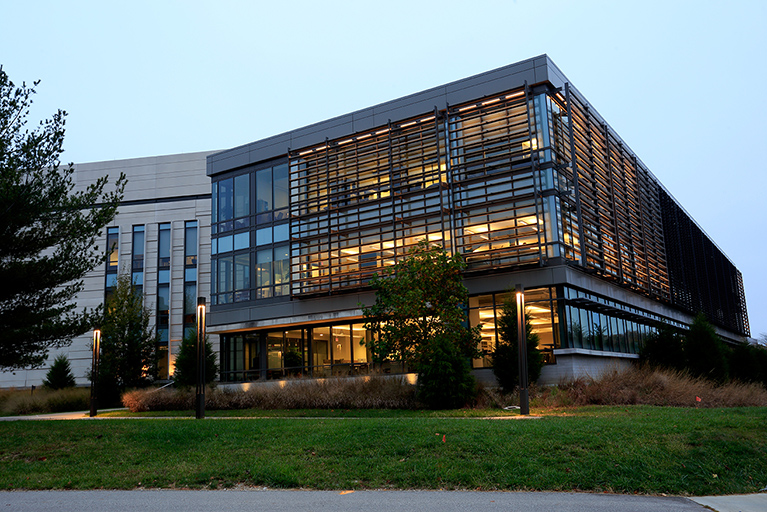The CIB serves education, business, and the community. The interactive work environment brings together more than 600 IU staff, previously dispersed in offices across campus. Bringing offices together under one roof means better focus on issues where IT@IU can make a significant difference.
Find directions, contact details, and more for the CIBThe CIB is for IU and for you
It’s easy bein’ green
In 2013, the CIB received Gold LEED (Leadership in Energy & Environmental Design) certification, an internationally recognized process for green building developed by the U.S. Green Building Council. It remains an energy-efficient, sustainable building model for the university.
A sustainable model for IU
The CIB set a new standard for university carbon footprints. The construction and design maximize sunlight and solar power, staff workspaces are designed for energy efficiency, and paperless document management is the norm.
Commuting
Fuel efficient and carpool vehicles. To contribute to lowering carbon emissions, the CIB offers preferred parking for carpooling and fuel-efficient vehicles.
Bike room. To encourage biking to work—good exercise and a means of reducing carbon emissions—the CIB has a secure, indoor bike storage area with room for 35 bikes.
Water management
Landscaping. Many of the plants outside the CIB are native to our region and were chosen for their hardiness. The CIB has no permanent irrigation systems.
Rooftop water drains. Rooftop water drains on the flat CIB roof transport rainwater through drains embedded in the building wall, to the rain gardens below.
Storm water. The rain gardens absorb much of the water from the roof. The tiers of soil and vegetation filter this runoff, reducing the amount of water flowing into storm drains.
Pint urinals. It takes only one pint of water to flush. Along with low-flush toilets, these help reduce water use.
Automatic faucets. Automatic faucets contribute to our goal of reducing water use by 40%.
Energy and atmosphere
Chillers. The “chiller unit” is made up of two, 200-ton, liquid-cooled chillers that maintain cooling and heating. This chiller was salvaged from the Wrubel Computing Center, saving the university the cost of buying a new one.
Louvers. Exterior louvers and interior sunshades work together to block or capture light as needed, according to the season. The louvers are in fixed positions to block summer sun coming in from a higher angle, and admitting winter light that enters from a lower angle.
Shades. The sunshades are programmed to adjust over the course of the day and year. They can be open all the way, half way, or at 25% intervals, according to the need for sunlight.
Reflective white roof. The roof is covered in a white rubber membrane that reflects the sun’s radiation, lowering the amount of heat absorbed by the building and contributing to the building’s overall energy efficiency.
Solar water panels. Rooftop solar water panels use the sun’s energy to heat a portion of the hot water needed in the building for the locker rooms, kitchens, bathrooms, and dining facilities.
Material Use
Recycling. The CIB Green Team encourages recycling. Staff recycle plastics (1–7), aluminum cans, batteries, paper, cardboard, and glass bottles. Trashcans are labeled “Landfill” as a reminder of the impact of landfill on the planet.
Water bottle filling station. Bottle filling stations set into the wall provide filtered drinking water throughout the building, eliminating the need for plastic. The digital readout logs the number of plastic bottles kept from the waste stream.
Print release stations. With very few exceptions, printing at the CIB is conducted through Print Release Stations located in the copy/scan rooms at the end of each wing. Staff pick up printouts at any printer by signing into a password-protected computer. Encouraging staff to “Print Less, Go Green” is an important part of lowering the environmental impact of our work.
Indoor environmental quality
Views and space. The glass-walled, light-filled CIB provides most staff a view to the outdoors. The open floors promote communication, collaboration, and creativity, and generous hallways and stairs encourage getting up and moving around.
Enclosed copy/scan rooms. Copy/scan rooms are enclosed to minimize the amount of paper and toner particles released into work areas.
Flushing the HVAC system. The building's heating and cooling systems were “flushed” before staff moved in to remove gases that can escape from new carpeting and wall paints. Filters placed over the vents capture particulates. This helps maintain cleaner air and comfortable temperatures and humidity.


